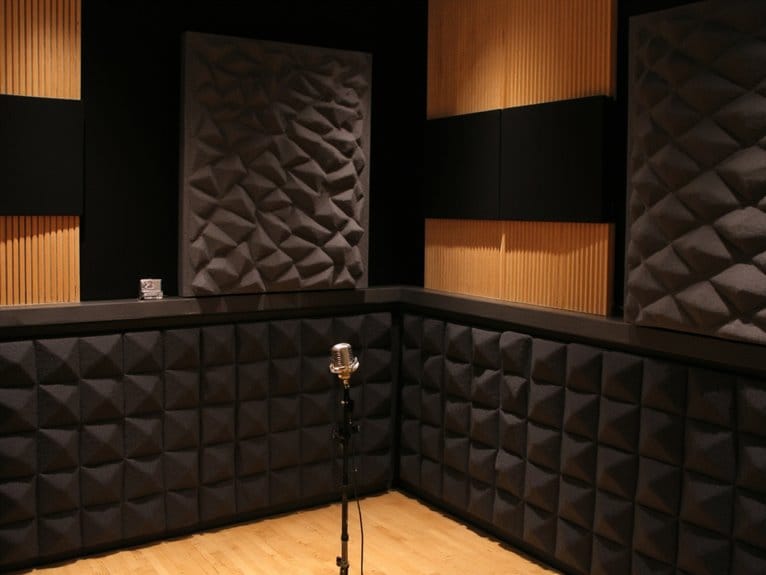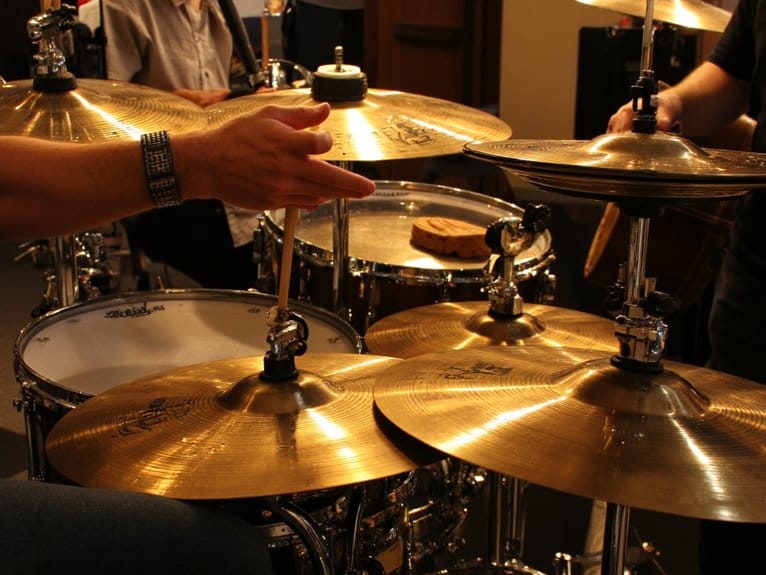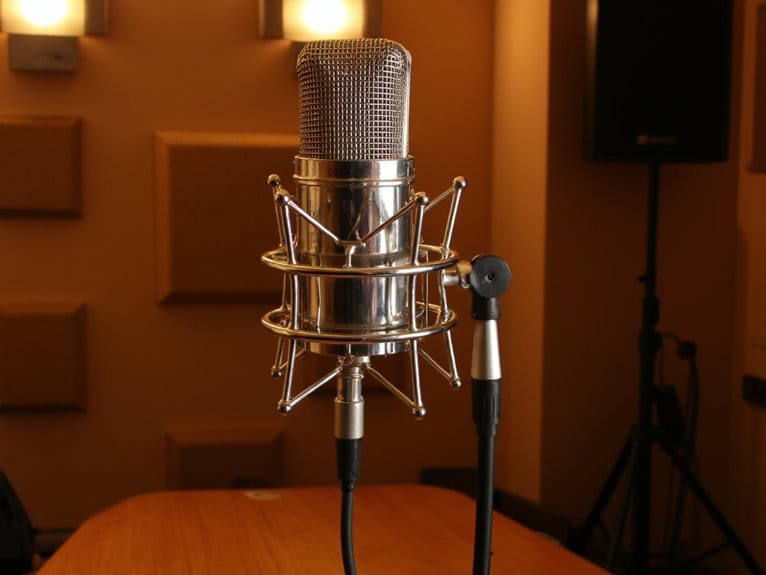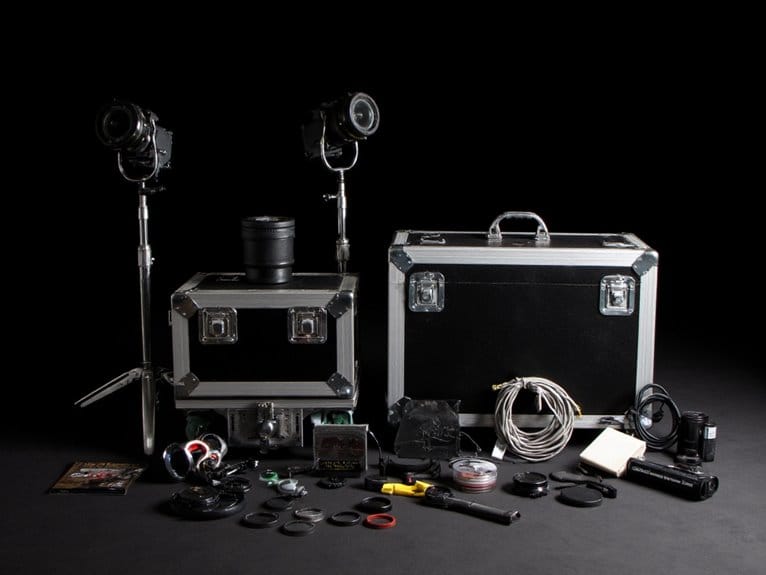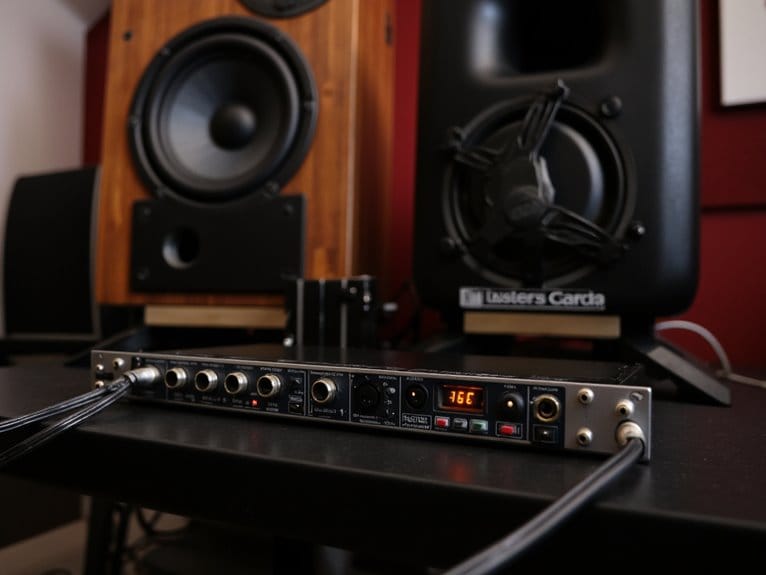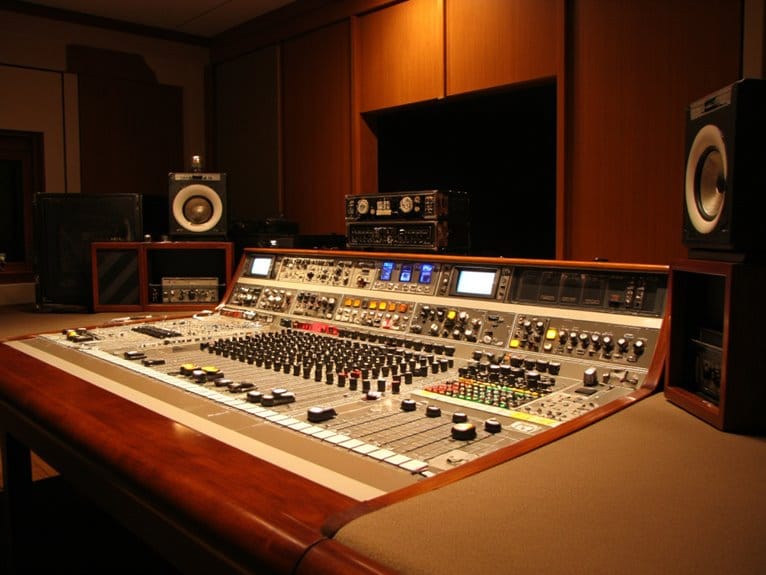Room Resonance Problems and Solutions
Room resonance occurs when sound waves bounce between parallel walls, creating standing waves that produce booming bass frequencies and dead zones where certain notes vanish completely. You’ll notice these problems most in rectangular rooms where axial modes between opposite surfaces generate strong resonances at predictable frequencies. Strategic placement of bass traps in corners, absorbers at reflection points, and diffusers on rear walls can tame these issues, while digital room correction systems like Dirac Live provide precise electronic solutions that complement physical treatments for thorough acoustic control.
We are supported by our audience. When you purchase through links on our site, we may earn an affiliate commission, at no extra cost for you. Learn more.
Notable Insights
- Room modes between parallel walls create standing waves that produce uneven bass response with hot spots and dead zones.
- Measure resonances using sound level meters, swept sine waves, and FFT analysis to identify problematic frequencies and locations.
- Rectangular rooms with specific dimensions create predictable resonances, while irregular geometries help disrupt standing wave patterns.
- Place bass traps in corners, absorbers at reflection points, and diffusers on rear walls for comprehensive acoustic treatment.
- Digital room correction systems like Dirac Live provide precise frequency response filtering beyond traditional physical treatments.
Understanding Room Modes and Standing Wave Formation
When you’re dealing with audio issues in your listening room, I’ve found that understanding room modes and standing waves is absolutely crucial for diagnosing why your system sounds muddy in some spots and thin in others.
These acoustic phenomena occur when sound waves reflect between parallel surfaces, creating resonant frequencies that interfere with your music’s natural balance. The most problematic are axial modes, which form between opposite walls and produce the strongest resonance effects, while tangential modes involve four surfaces but carry less acoustic energy.
Axial modes between opposite walls create the strongest acoustic interference, while tangential modes involving four surfaces produce weaker resonance effects.
Standing waves develop fixed patterns of pressure zones throughout your space, resulting in those frustrating “hot spots” where bass booms excessively and “dead zones” where frequencies seemingly disappear. Effective DSP capabilities can help mitigate these acoustic issues by providing noise reduction and distortion control during both recording and playback phases.
This makes proper speaker placement and room treatment essential for achieving consistent sound quality. Modern audio interfaces can help you monitor and analyze these room acoustics issues during the recording and mixing process, allowing you to make informed decisions about treatment placement.
Identifying and Measuring Acoustic Resonances in Your Space
Now that you understand how these acoustic phenomena create uneven sound distribution throughout your room, the next logical step involves actually measuring where these resonances occur and how severely they’re affecting your listening experience.
You’ll need sound level meters equipped with frequency analysis capabilities, microphones positioned strategically throughout your space, and measurement calibration to guarantee accurate readings.
Start by generating swept sine waves or broadband noise from an omnidirectional speaker, then capture the acoustic response using properly calibrated instruments.
Fast Fourier Transform analysis will reveal frequency peaks corresponding to problematic resonances. Various resonance detection methods, including accelerometers and specialized software, help identify specific modal frequencies and their spatial patterns, giving you concrete data to address your room’s acoustic challenges effectively.
How Room Geometry Creates Bass Problems
Understanding your room’s geometry is essential because the physical dimensions of your space directly determine which bass frequencies will cause the most trouble. I’ve seen countless listeners struggle with boomy, uneven low-end simply because their room’s length, width, or height creates perfect conditions for standing wave formation.
Rectangular rooms with parallel walls generate predictable resonances at frequencies where wavelengths match dimensional distances, creating peaks and nulls throughout your listening space.
Parallel walls create standing waves when sound wavelengths align with room dimensions, causing uneven bass response.
Different room shapes can actually help-angled walls and irregular geometries disrupt these patterns, though they complicate treatment strategies. Surface angles break up direct wave reflections, reducing standing wave intensity compared to perfectly parallel surfaces.
Larger rooms extend reverberation times while smaller spaces intensify modal problems within musical frequency ranges.
Acoustic Treatment Strategies for Resonance Control
Once you’ve identified which frequencies are causing problems in your room, the solution lies in strategically deploying acoustic treatments that target these specific resonances.
I’ve found that a systematic approach combining bass traps, absorbers, and diffusers will transform even the most challenging spaces into controlled listening environments.
Start with broadband bass trap types in your room’s corners, where low-frequency energy accumulates most severely. These cost-effective solutions address wide frequency ranges without requiring precise tuning.
Your absorption strategies should focus on first reflection points using thick panels that work across multiple frequency bands.
While I recommend placing diffusers on rear walls to maintain room liveliness and prevent that overly dead sound that makes mixing feel unnatural.
Electronic Solutions and Room Correction Techniques
While physical acoustic treatments handle the bulk of your room’s resonance issues, digital room correction systems offer surgical precision for fine-tuning what remains, and I’ve learned that these electronic solutions can address problems that would be impossible to fix with foam and fabric alone. Digital correction systems like Dirac Live measure your room’s acoustic fingerprint using precision microphones, then create custom filters that compensate for frequency response anomalies and timing issues in real-time.
| Traditional EQ | Advanced Room Correction |
|---|---|
| Basic parametric adjustments | FIR/IIR filters with phase alignment |
| Single listening position | Multi-point optimization |
| Limited bass control | Precise resonance targeting |
These room optimization tools excel when you’re dealing with structural limitations like large windows or open floor plans, where physical treatments aren’t feasible or sufficient.
On a final note
You’ve now got the tools to tackle those pesky room resonances that’ve been muddying your sound. Whether you choose acoustic panels, bass traps, or digital room correction, I’ve found that combining multiple approaches works best. Don’t expect perfection overnight-room acoustics is an iterative process that requires patience and experimentation. Start with the biggest problems first, measure your progress, and you’ll gradually transform your space into something truly special.

